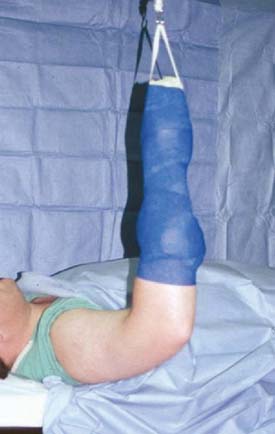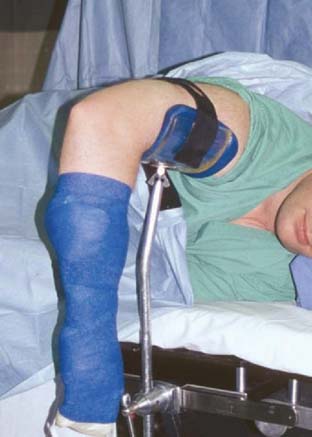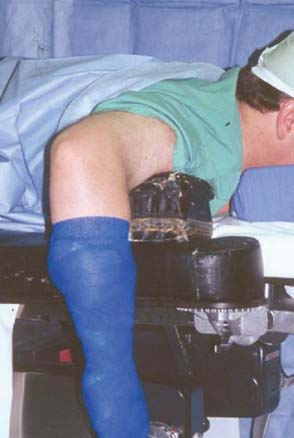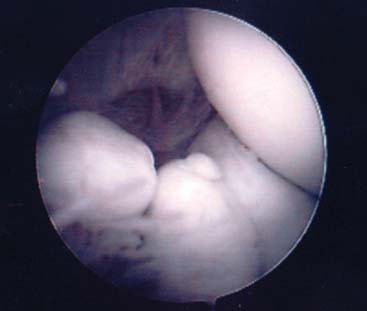CHAPTER 37 Diagnostic Arthroscopy: Indications, Portals, and Techniques
HISTORY
In 1932, Michael Burman concluded in the Journal of Bone and Joint Surgery that the elbow joint was “unsuitable for examination” arthroscopically.8 Since that time, advances in arthroscopy and equipment have made elbow arthroscopy safe and effective in the management of a variety of elbow disorders. Elbow arthroscopy is a technically demanding procedure that requires a thorough knowledge of the neurovascular anatomy of the elbow. The original indications for elbow arthroscopy only included the diagnosis and removal of loose bodies. As techniques have advanced, the indications for elbow arthroscopy have expanded to include the treatment of synovitis, osteochondritis dissecans, capsular contractures, arthritis, fractures, lateral epicondylitis, and instability.28,29,34,48
Elbow arthroscopy was originally performed with the patient in the supine position and the hand suspended to traction. Because of poor access to the posterior aspect of the elbow, Poehling et al.35 popularized the prone position for elbow arthroscopy. The lateral decubitus position has been advocated by O’Driscoll and Morrey.29 The arm is positioned with the involved side up, the elbow flexed at 90 degrees, and the arm supported by a padded bolster. This position allows better access to both anterior and posterior compartments.
INDICATIONS AND CONTRAINDICATIONS
The indications for elbow arthroscopy include the removal of loose bodies,7,18,23,26–28,40 removal of osteophytes secondary to osteoarthritis,25,30 radial head resection,20 release of capsular contractures and adhesions,9,14 and the resection of symptomatic plica.4,11 Other in-dications include the treatment of osteochondritis dissecans,6,28,37,42 fractures,3,24,28 lateral epicondylitis,5,44 instability,45 septic arthritis,48 synovectomy,3,48 and evaluation of patients with chronic elbow pain.28
Multiple studies have demonstrated the effectiveness of elbow arthroscopy for the diagnosis and treatment of loose bodies. Success rates have been reported in the 90% range.7,18,26,27 Elbow arthroscopy for loose bodies is indicated in symptomatic patients who fail to respond to conservative treatment. The operating surgeon should attempt to determine the etiology of the loose body. Loose bodies are often a result of osteochondritis dissecans. Other causes include trauma, arthritis, or synovial osteochondromatosis. It is essential that the operating surgeon determines the source of loose bodies because the outcome of the patient will be determined by the disease, not just the removal of loose fragments.42
SURGICAL TECHNIQUES
ANESTHESIA
Elbow arthroscopy can be performed under general or regional anesthesia. General anesthesia allows for complete muscle relaxation and flexibility of the patient.35 In an awake patient with regional anesthesia, the prone or lateral decubitus position may be poorly tolerated.17 Neurologic function can also be monitored postoperatively with general anesthesia alone.
Regional anesthesia with a scalene, axillary, or Beir intravenous regional block may also be used if the patient cannot undergo general anesthesia. The axillary block does not always achieve complete anesthesia about the elbow. Regional anesthesia may limit operative time secondary to longevity of the anesthetic agent or the intolerance of the patient to the tourniquet in a Beir block.
POSITIONING
Supine Position
In the supine position, first reported by Andrews and Carson3 in 1985, the patient lies supine with the shoulder over the edge of the operating table. The shoulder is abducted to 90 degrees and is in neutral rotation with 90 degrees of elbow flexion. The elbow is suspended by a traction device that is attached to either the hand or forearm (Fig. 37-1).
There are several advantages of the supine position in elbow arthroscopy.19,21 The supine position allows the anesthesiologist an easier access to the patient’s airway, and there is more flexibility to the choice of anesthesia. The conceptualization of the intra-articular anatomy is facilitated with the elbow in the supine position with the elbow joint in a more familiar anatomic orientation. Conversion of an arthroscopic procedure to an open procedure is readily facilitated in the supine position when required.
Prone Position
In response to the disadvantages of the supine position, Poehling and associates35 described the prone position for elbow arthroscopy. The patient is placed prone on the operating table over chest rolls to ensure adequate ventilation. The shoulder is abducted to 90 degrees, and the arm is supported by an arm positioner or an arm board (Fig. 37-2). The arm board is placed parallel to the operating table, centered at the shoulder. A sandbag, foam support, or rolled blankets are placed under the upper arm to elevate the shoulder and allow the elbow to rest in 90 degrees of flexion.
Advantages of the prone position are improved access and visualization of the posterior compartment of the elbow. Because the forearm hangs freely from the arm board, the elbow is easily manipulated from near full flexion to full extension. In the prone position, the anterior aspect of the elbow is facing inferiorly toward the floor, which allows neurovascular structures to fall anteriorly away from the joint. This provides an additional margin of safety when establishing portals. No special equipment or additional personnel are needed because the elbow position on the arm board is stable. The prone position, like the supine position, allows for easy conversion to an open procedure.39
Lateral Decubitus Position
The lateral decubitus position, first described by O’Driscoll and Morrey,29 combines the advantages of the supine and prone position while avoiding some of the pitfalls of each position. The patient is placed in the lateral decubitus position, with the arm positioned in an arm holder or over a bolster. The shoulder is flexed to 90 degrees and internally rotated, and the elbow flexed 90 degrees over a padded bolster (Fig. 37-3).
PORTALS
Surface landmarks are marked on the skin before creating portals. Important landmarks to outline are the radial head, olecranon, lateral epicondyle, medial epicondyle, and ulnar nerve. Before making portals, the joint must be distended with 20 to 30 mL of sterile saline (see Fig. 37-1). This can be done by placing an 18-gauge spinal needle either in the olecranon fossa or the soft spot bounded by the lateral epicondyle, olecranon, and radial head. Neurovascular structures are displaced away from the joint with distension of the joint, which gives an additional margin of safety.15,16
Proximal Anteromedial
Poehling and associates35 first described the proximal anteromedial portal in 1989. This portal is located 2 cm proximal to the medial epicondyle and just anterior to the medial intermuscular septum (Fig. 37-4). The medial intermuscular septum is identified by palpation, and the portal is made anterior to the septum so that the ulnar nerve is not injured. The blunt trocar is introduced into the portal, anterior to the septum, and aimed toward the radial head while maintaining contact with the anterior surface of the humerus. This allows the brachialis muscle to remain anterior and protect the median nerve and brachial artery. The trocar enters the elbow through the tendinous origin of the flexor-pronator group and medial capsule.17
The proximal anteromedial portal has been recommended as the initial portal used with the patient in the prone or lateral decubitus position.15,35 This portal is thought to offer safer access and better visualization of the joint. In addition, fluid extravasation may be less with this portal compared with the anterolateral portal.15 Visualization of the entire aspect of the anterior aspect of the joint including the anterior capsule, trochlea, capitellum, coronoid process, radial head, and medial and lateral gutters can be obtained with this portal.
The primary structure at risk with this portal is the posterior branch of the medial antebrachial cutanenous nerve.46 This nerve is located approximately 2.3 mm from the trocar. With the elbow in flexion, the median nerve is relatively safe, protected by the brachialis muscle, being located on average a distance of 12.4 to 22 mm from the trocar.15,46 The path of the trocar aims distally and is in a parallel orientation to the median nerve making injury to the nerve less likely. The ulnar nerve is located on average a distance of 12 to 23.7 mm from the portal.15,46 The ulnar nerve is not at risk as long as the portal is made anterior to the intermuscular septum. Contraindications to the use of this portal are a history of subluxation or transposition of the ulnar nerve from its groove.15,32,46 Care must be taken to ensure that the ulnar nerve is not subluxed before anteromedial portal placement. This portal may be used in these circumstances only if the nerve is identified prior to trocar entry.
Anteromedial Portal
The anteromedial portal, first described by Andrews and Carson,3 is positioned 2 cm distal and 2 cm anterior to the medial epicondyle (Fig. 37-5). With the elbow flexed to 90 degrees, the blunt trocar is aimed at the center of the joint, passing through the flexor-pronator origin and the brachialis muscle before entering the joint capsule anterior to the medial collateral ligament. This portal may also be established by using an inside-out technique, with the arthroscope in the lateral portal.15 The entire anterior compartment of the elbow, especially the lateral structures, can be visualized from this portal. The medial antebrachial cutaneous nerve is at greatest risk of being injured, located on average 1 mm from the portal.22,46 The median nerve is in closer proximity to this portal being located on average a distance of 7 to 14 mm.16,46 Lindenfeld15 reports an average distance of 22 mm from the portal to the median nerve if this portal is established 1 cm anterior to the medial epicondyle.
Stay updated, free articles. Join our Telegram channel

Full access? Get Clinical Tree













